The Game of Life Write a complete C program that implements
The Game of Life
Write a complete C program that implements Conway\'s Game of Life.
The rules for the Game of Life are simple. The universe consists of a two-dimensional matrix of cells with each cell being alive or dead. For each generation every cell determines its next phase of life as follows:
If the cell is alive:
it dies if it has 0, 1, 4 or more living neighbours (starvation), or
it lives if it has 2 or 3 living neighbours (balance).
If the cell is dead:
it springs to life if it has exactly 3 neighbours (procreation).
A cycle occurs as soon as the state of the universe of the latest generation is the same as a previous generation. You should be able to see that once this occurs the Game of Life will repeat the intermediate generations forever.
Implementation Requirements
All of the following conditions must be met by your solution.
Your program must read the initial state from standard input (redirecting files on the command line is the way to go!).You will be expected to adequately test your program All input will conform to the following format:
The input will consist of starting universes for multiple games. Play each game completely, in the order they appear in the file.
The first line of the game starts with an asterisk and contains the game title.
The second line of the game contains two numbers, separated by a space, which indicate the number of rows and columns for the 2-D matrix.
Then there is one line for each row in the matrix:
A blank character represents a dead cell.
An \'X\' represents an alive cell.
The next game starts on the next line, until EOF.
There are no errors in the input file format.
For each game, your program will first print the game title as read from the file. Print the starting universe as read in. Then, after each generation is calculated your program will print the current state of the universe. All printing goes to standard output, and each universe must be preceded by a label indicating the generation number (where the initial state is generation 0). You must include a border, use \'.\' for dead cells and \'*\' for alive cells.
Each game will run for 250 generations or until a cycle is detected, whichever comes first. If the game ends because of a cycle, print the numbers of the two generations that were duplicated.
Printing all generations is great for debugging purposes (and should prove mesmerizing). But the release version of your program, when compiled with -DNDEBUG, should only print the initial universe and the last 10 (or less) generations. The sample output above is produced by a release version.
Hints
The following should help point you in the right direction:
Store the universe in a two-dimensional array, but be careful that your program avoids subscripting your array \"out of bounds\". Not checking for array boundaries may lead to your program crashing, or worse, giving the wrong results.
You will need to store all previous generations in order to identify a cycle. To do this, consider using a struct to represent a generation. Then, you can employ an array of objects to track your universe\'s history.
You may assume file input lines are at most 80 characters, and a universe is at most 60x60 cells.
Here is a sample input file to use for testing.
Solution
C CODE:
#include <stdio.h>
#include <stdlib.h>
#include <string.h>
#include <time.h>
#include <math.h>
#include <SDL/SDL.h>
#include <SDL/SDL_image.h>
#define OFF 0
#define ON 1
#define BLACK 8, 0, 0, 0, 0
#define scr_width 600
#define scr_height 600
#define cell_width (scr_width / ROWS)
#define cell_height (scr_height / COLS)
int ROWS,COLS;
scanf(\"%d %d\",&ROWS,&COLS);
char board[ROWS][COLS];
char temp[ROWS][COLS];
SDL_Rect cells[ROWS][COLS];
void randomize_board(void);
void initialize_grid(SDL_Surface* screen);
void blit_board(SDL_Surface* bcell, SDL_Surface* screen);
int num_neighbours(int x, int y);
void update_board(void);
int clear_board(SDL_Surface* screen, Uint32 color);
int clear_cell(SDL_Surface* screen, int x, int y, Uint32 color);
void initialize_cells_array(void);
int main(void) {
SDL_Init(SDL_INIT_VIDEO);
SDL_WM_SetCaption(\"Conway\'s Game of Life - Ryuurei\", NULL);
SDL_Event event;
int breaker = 0;
int paused = 1;
SDL_Surface* screen = SDL_SetVideoMode(
scr_width, scr_height, 0,
SDL_SWSURFACE);
if (! screen) {
perror(\"SDL_SetVideoMode\");
return EXIT_FAILURE;
}
Uint32 bgcolor = SDL_MapRGB(screen->format, 0xFF, 0xFF, 0xFF);
if (SDL_FillRect(screen, &(screen->clip_rect), bgcolor) == -1) {
perror(\"SDL_FillRect\");
return EXIT_FAILURE;
}
initialize_cells_array();
initialize_grid(screen);
SDL_Surface* bcell = SDL_CreateRGBSurface(
SDL_SWSURFACE, cell_width, cell_height, BLACK);
if (! bcell) {
perror(\"BLACK SDL_CreateRGBSurface\");
return EXIT_FAILURE;
}
SDL_Flip(screen);
while (1) {
while (SDL_PollEvent(&event)) {
switch (event.type) {
case SDL_QUIT:
breaker = 1;
break;
case SDL_KEYDOWN:
if (event.key.keysym.sym == SDLK_KP_ENTER ||
event.key.keysym.sym == SDLK_RETURN) {
paused = !paused;}
else if (event.key.keysym.sym == SDLK_SPACE) {
SDL_FillRect(screen, &(screen->clip_rect), bgcolor);
randomize_board();
}
else if (event.key.keysym.sym == SDLK_ESCAPE) {
breaker = 1;
break;
}
else if (event.key.keysym.sym == SDLK_RSHIFT ||
event.key.keysym.sym == SDLK_LSHIFT) {
if (clear_board(screen, bgcolor) == -1) {
perror(\"clear_board\");
return EXIT_FAILURE;
}
}
break;
case SDL_MOUSEBUTTONDOWN:
if (event.button.button == SDL_BUTTON_LEFT) {
if (event.button.y > (ROWS * cell_height)) break;
int tx = floor(event.button.x / cell_width);
int ty = floor(event.button.y / cell_height);
if (board[tx][ty] == OFF) {
board[tx][ty] = ON;
temp[tx][ty] = ON;
SDL_BlitSurface(
bcell,
&(bcell->clip_rect),
screen,
&cells[tx][ty]);
} else if (clear_cell(screen, tx, ty, bgcolor) == -1) {
perror(\"clear_cell\");
return EXIT_FAILURE;
}
}
break;
default: continue;
}
if (breaker)
break;
}
if (breaker)
break;
initialize_grid(screen);
blit_board(bcell, screen);
SDL_Flip(screen);
if (!paused) {
update_board();
SDL_Delay(250);
SDL_FillRect(screen, &(screen->clip_rect), bgcolor);
}
}
return EXIT_SUCCESS;
}
void randomize_board(void) {
memset((void *)board, OFF, ROWS * COLS);
for (int y = 0; y < ROWS; y++) {
for (int x = 0; x < COLS; x++) {
if (rand() % 5 == 0) {
board[x][y] = ON;
}
temp[x][y] = board[x][y];
}
}
}
void initialize_grid(SDL_Surface* screen) {
SDL_Surface* linex = SDL_CreateRGBSurface( /* Vertical lines */
SDL_SWSURFACE, 1, scr_height, BLACK);
SDL_Surface* liney = SDL_CreateRGBSurface( /* Horizontal lines */
SDL_SWSURFACE, scr_width, 1, BLACK);
SDL_Rect pos_x;
SDL_Rect pos_y;
pos_x.y = pos_y.x = 0;
for (int i = 0; i < scr_width / (cell_width); i++) {
pos_x.x = cell_width + cell_width * i;
SDL_BlitSurface(linex, &(linex->clip_rect), screen, &pos_x);
}
for (int i = 0; i < scr_height / (cell_height); i++) {
pos_y.y = cell_height + cell_height * i;
SDL_BlitSurface(liney, &(liney->clip_rect), screen, &pos_y);
}
}
void blit_board(SDL_Surface* bcell, SDL_Surface* screen) {
for (int y = 0; y < ROWS; y++) {
for (int x = 0; x < COLS; x++) {
if (board[x][y] == ON) {
SDL_BlitSurface(
bcell,
&(bcell->clip_rect),
screen,
&cells[x][y]);
}
}
}
}
int num_neighbours(int x, int y) {
int num_adj = 0;
int tmpy = y;
int tmpx = x;
if (y-1 < 0)
tmpy = ROWS - 1;
else
tmpy = y - 1;
if (board[x][tmpy] == ON) num_adj++;
if (y+1 >= ROWS)
tmpy = 0;
else
tmpy = y + 1;
if (board[x][tmpy] == ON) num_adj++;
if (x-1 < 0)
tmpx = COLS - 1;
else
tmpx = x - 1;
if (board[tmpx][y] == ON) num_adj++;
if (x+1 >= COLS)
tmpx = 0;
else
tmpx = x + 1;
if (board[tmpx][y] == ON) num_adj++;
if (y-1 < 0)
tmpy = ROWS - 1;
else
tmpy = y - 1;
if (x-1 < 0)
tmpx = COLS - 1;
else
tmpx = x - 1;
if (board[tmpx][tmpy] == ON) num_adj++;
if (x+1 >= COLS)
tmpx = 0;
else
tmpx = x + 1;
if (board[tmpx][tmpy] == ON) num_adj++;
if (y+1 >= ROWS)
tmpy = 0;
else
tmpy = y + 1;
if (x+1 >= COLS)
tmpx = 0;
else
tmpx = x + 1;
if (board[tmpx][tmpy] == ON) num_adj++;
if (x-1 < 0)
tmpx = COLS - 1;
else
tmpx = x - 1;
if (board[tmpx][tmpy] == ON) num_adj++;
return num_adj;
}
void update_board(void) {
int neighbours = 0;
for (int y = 0; y < ROWS; y++) {
for (int x = 0; x < COLS; x++) {
neighbours = num_neighbours(x, y);
if (neighbours < 2 && board[x][y] == ON) {
temp[x][y] = OFF; /* Dies by underpopulation. */
} else if (neighbours > 3 && board[x][y] == ON) {
temp[x][y] = OFF; /* Dies by overpopulation. */
} else if (neighbours == 3 && board[x][y] == OFF) {
temp[x][y] = ON; /* Become alive because of reproduction. */
}
}
}
for (int y = 0; y < ROWS; y++) {
for (int x = 0; x < COLS; x++) {
board[x][y] = temp[x][y];
}
}
}
int clear_board(SDL_Surface* screen, Uint32 color) {
for (int y = 0; y < ROWS; y++) {
for (int x = 0; x < COLS; x++) {
board[x][y] = OFF;
temp[x][y] = OFF;
}
}
return SDL_FillRect(screen, &(screen->clip_rect), color);
}
int clear_cell(SDL_Surface* screen, int x, int y, Uint32 color) {
SDL_Rect rect;
rect.x = cell_width * x;
rect.y = cell_height * y;
board[x][y] = OFF;
temp[x][y] = OFF;
return SDL_FillRect(screen, &rect, color);
}
void initialize_cells_array(void) {
for (int y = 0; y < ROWS; y++) {
for (int x = 0; x < COLS; x++) {
(cells[x][y]).x = (cell_width * x);
(cells[x][y]).y = (cell_height * y);
}
}
}
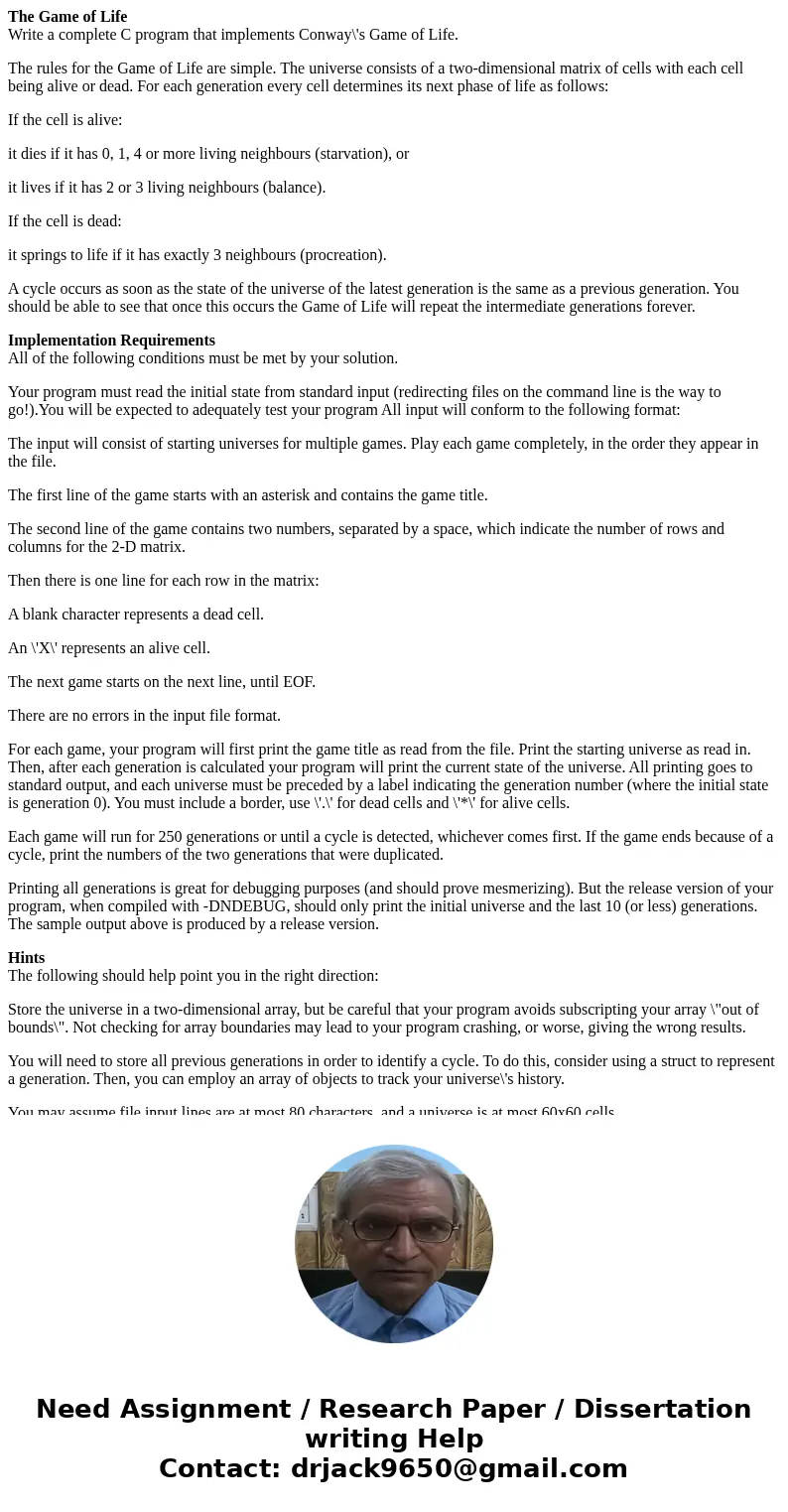
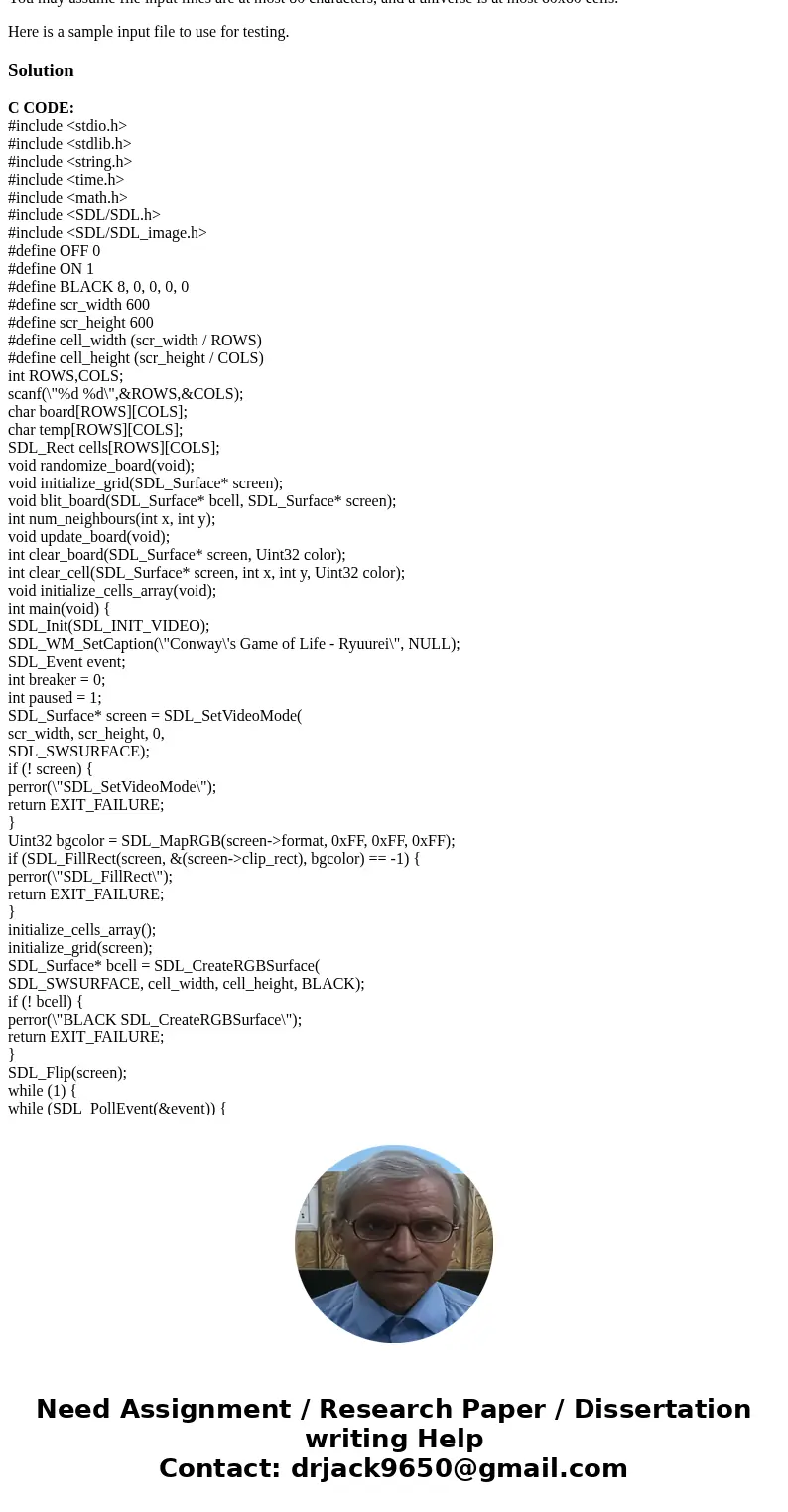
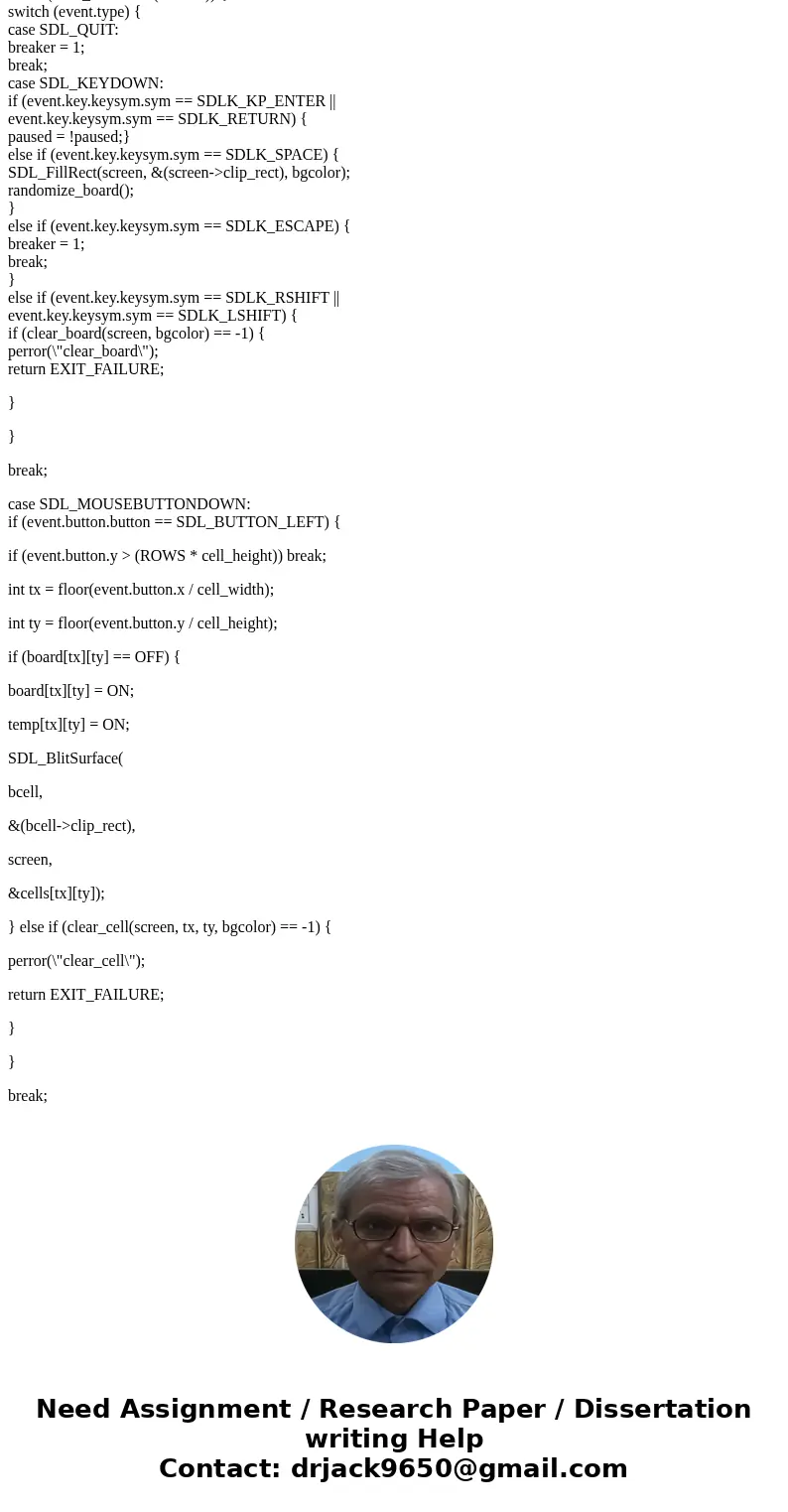
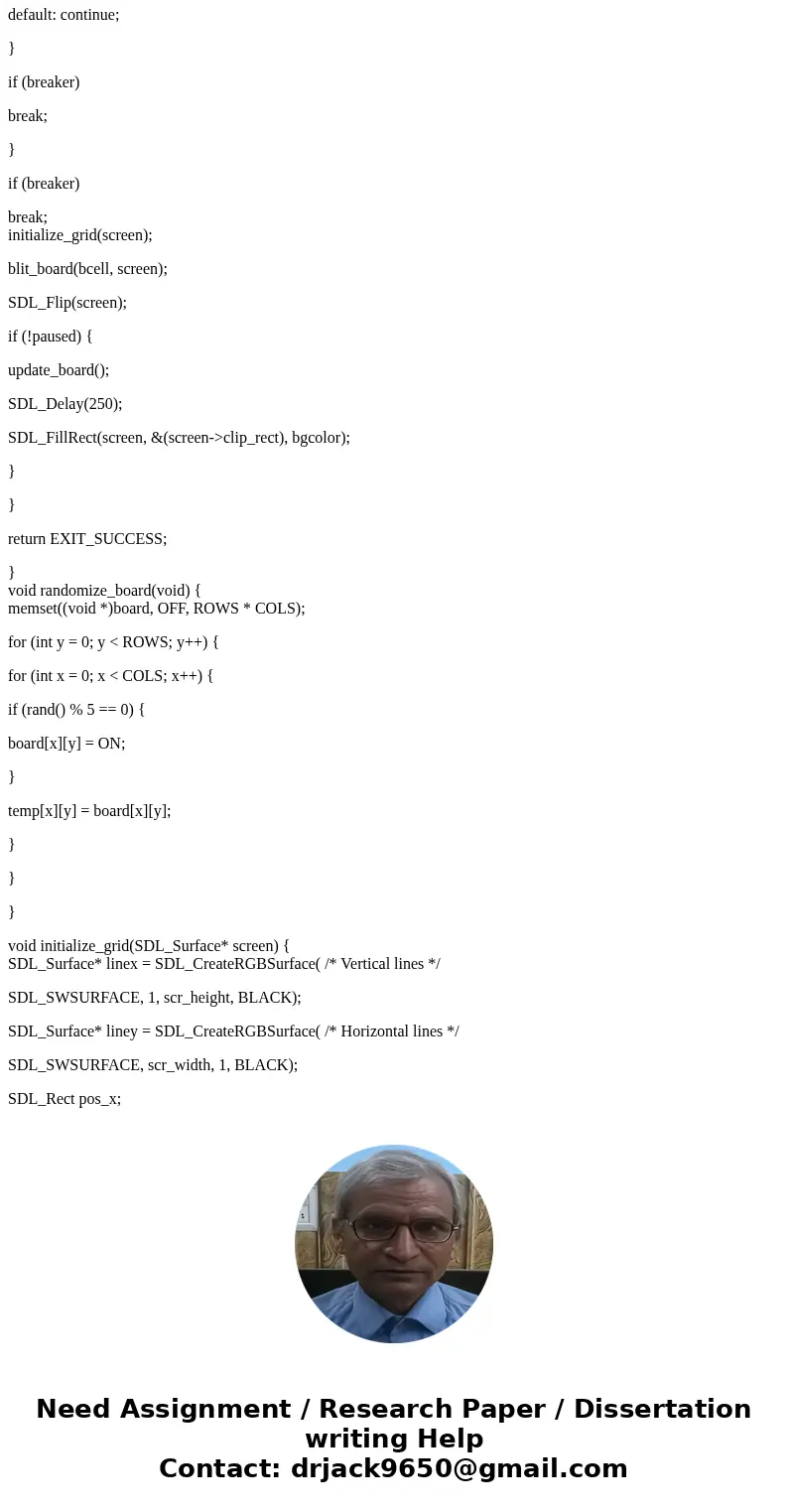
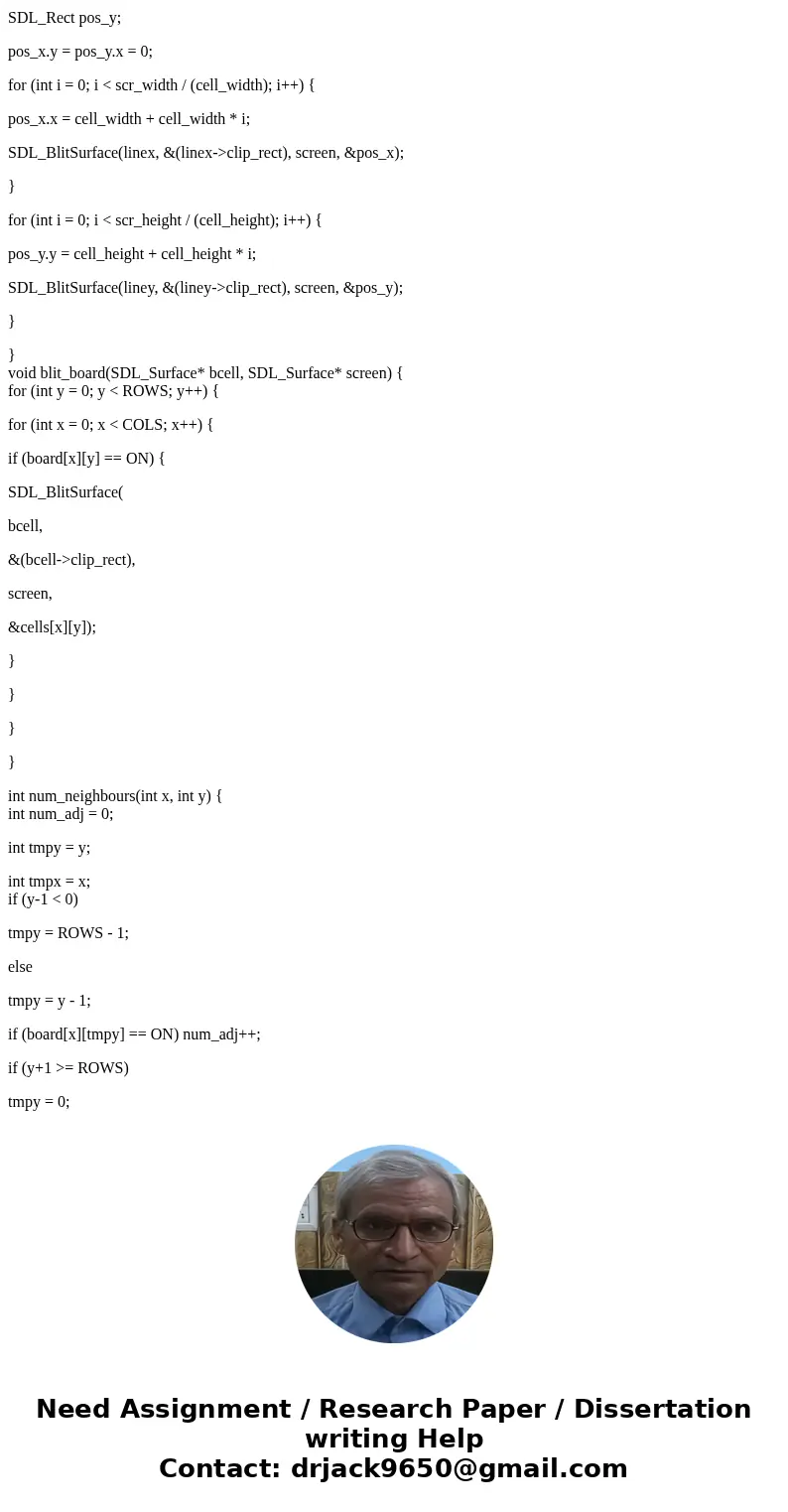
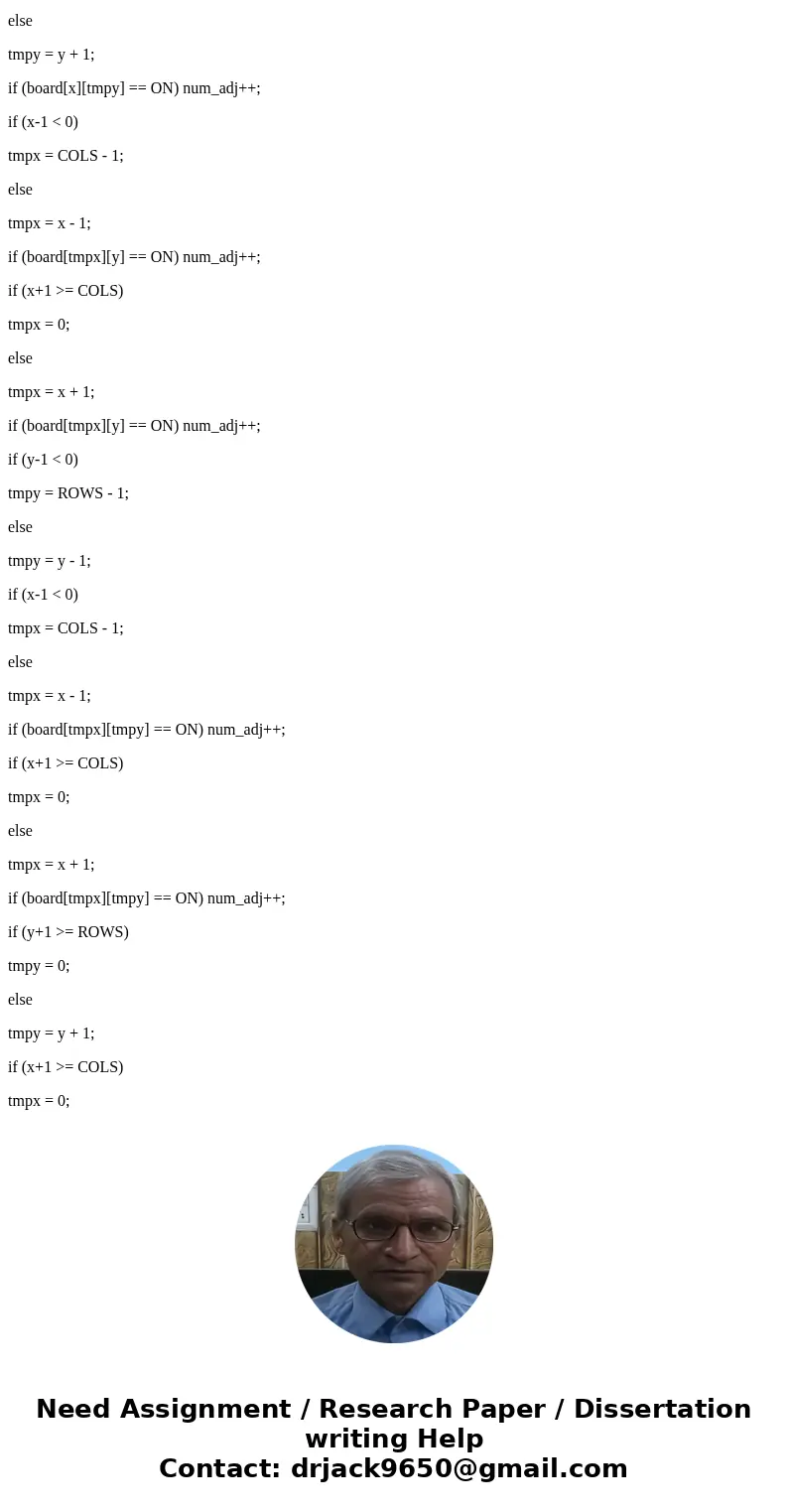
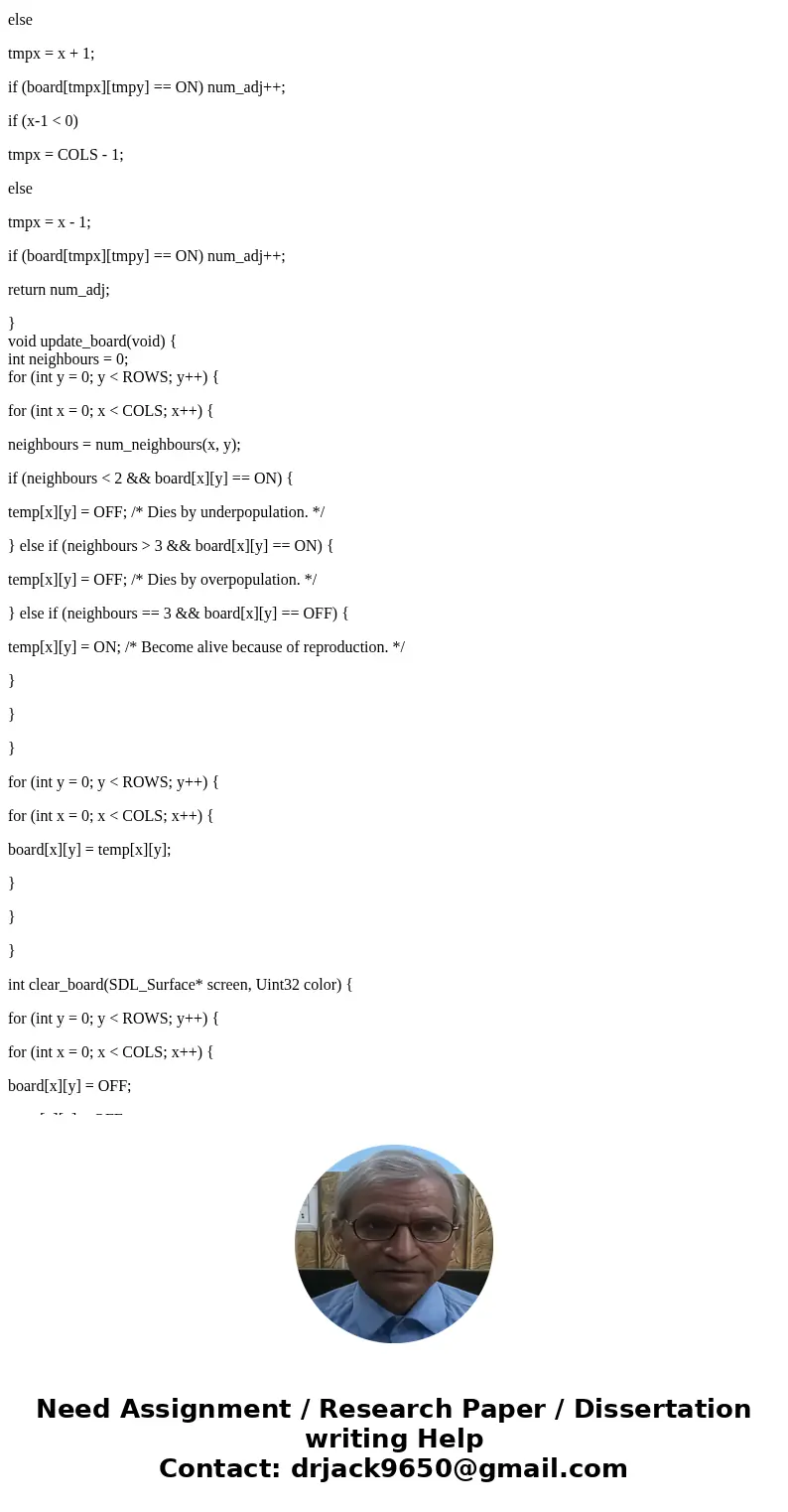
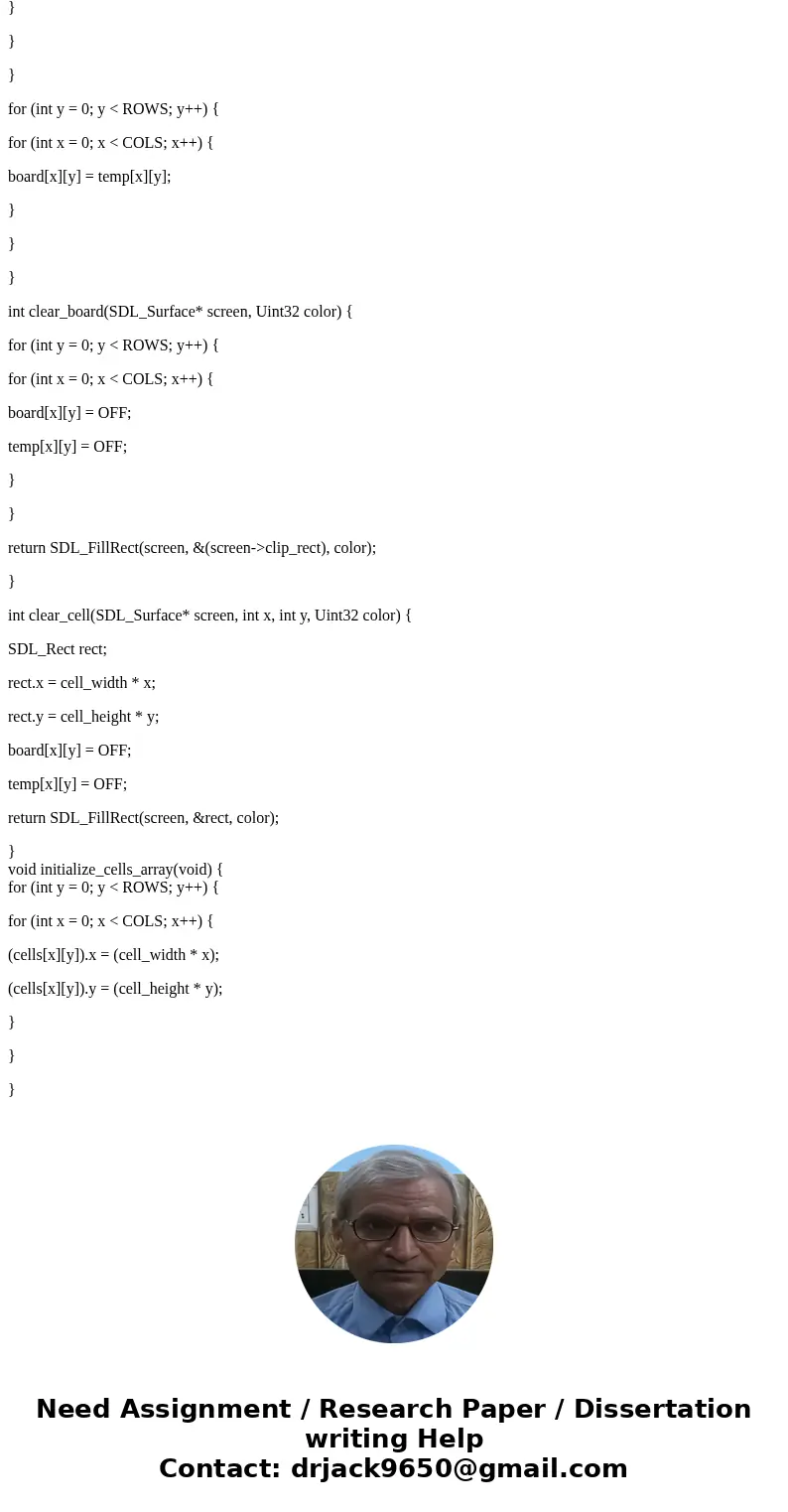
 Homework Sourse
Homework Sourse